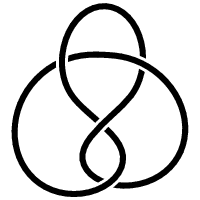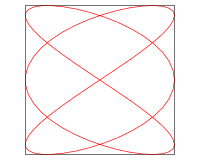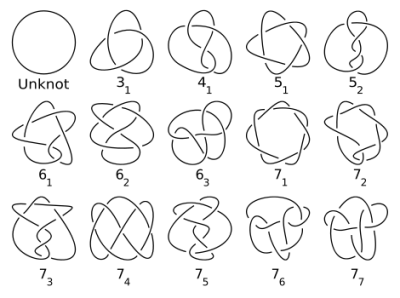Today we explore the topic of Knot Theory. Most of us have a conventional idea of what a “knot” is; and those who were once Boy Scouts may have a more formal idea. But in mathematics, a knot has a very formal defintion: an embedding of a circle in 3-dimensional Euclidean space, R3, considered up to continuous deformations (isotopies). An example of a mathematical knot, the “figure eight knot”, is illustrated below:

Basically, it is a continuous curve in three-dimensional space that loops back on itself, crossing an arbitrary number of times but never cut or spliced. It relates to the conventional notion of knot as a piece of string connected at the ends.
Knots relate to other topics that have been explored here at CatSynth, such as Lissajous curves.

Many knots, when projected onto a two-dimensional plane form Lissajous curves.
It also relates to our interest here at CatSynth in highway interchanges, such as this the intersection of I-105 and I-110 in Los Angeles:
Indeed, our friend whaleshaman of Jelly Pizza suggested the link between highway interchanges and knots, although mathematically such interchanges are really tangles.
Knots (and tangles) can be arbitrarily complex with twists and crossings. But there is order in this twisty world, and indeed knots have properties analogous to numbers, such as equivalency and prime decomposition.
Two knots are considered equivalent if one can be converted to another by simple scaling (stretching or rotating), or performing one of several Reidemeister moves, twisting or untwisting in either direction, moving one loop (or segment) completely over another, or move a string completely over or under another crossing. Basically, this is any operation you can do on a closed string without cutting or splicing it.
Here at CatSynth, we are quite familiar with Reidemeister moves, as they seem to occur spontaneously on our audio cables:

Even more interesting is how knots can be decomposed into prime knots. Just as any integer can be expressed as the product of prime numbers, any knot can be expressed as the “sum” of prime knots.
Here is a chart of the first 15 prime knots:

[Click image for original and more info]
Here, the prime knots are grouped by the number of crossings. For example, the trifoil knot (second from the left on the top) has three crossings. The circle is a degenerate case, known as the “unknot”, with zero crossings. As the number of crossings increases, the number of possible prime knots also increases. For example, there are seven unique prime knots with seven crossings.
For any positive integer n, there are a finite number of prime knots with n crossings. The first few values are given in the following table.
| n | number of prime knots | |
| 1 | 0 | |
| 2 | 0 | |
| 3 | 1 | |
| 4 | 1 | |
| 5 | 2 | |
| 6 | 3 | |
| 7 | 7 | |
| 8 | 21 | |
| 9 | 49 | |
| 10 | 165 | |
| 11 | 552 | |
| 12 | 2176 | |
| 13 | 9988 | |
| 14 | 46972 | |
| 15 | 253293 | |
| 16 | 1388705 |
This sequence (formally listed as A002863), appears to grow exponentially. Indeed, results by Welsh show a lower bound of 2.68 for the exponential base, and an upper bound of 10.40 due to Stoimenow. However, as far as I can tell, there is know known analytical formula for this sequence, and the values for n=17 and above are not known.
I find such sequences of numbers fascinating. Where to they come from, and how does one figure out the next value? In the case of prime knots, these appear to be open problems.
For more information, Giovanni de Santi has an excellent introduction to the theory of knots. Another paper by [url=http://algo.inria.fr/bsolve/constant/constant.html]Steven R. Finch is a resource for advanced analysis of knots and tangles, including more on counting prime knots.


well, i’m not sure about math, but i looove chewing on knots!! hugs to you all today in memory of MuShue!
Wow Luna, you sure are smart. And pretty too!
Luna, you have great combo – pretty and smart. 🙂
Interesting topic!
When I started reading I thought you would relate it to some kind of synthesis or something.
Well, try to find out how does one figure out the next value.. figure it out by yourself and get lots of money! 😀
hehehe
Cheers,
Breno Ronchini
Wow.. I have been looking for this info for a while. This is very informative and detailed. You must be putting so much time into your blog 🙂 Thanks for the post! iLL have you bookmarked.
Dat furry intursting….
wonder if shue shue string duz dats whn Ize knots lookin…
=^..^=
Today was our purrents anniefursaree!! Yay!!
Thanks for the info!! I like your blog, i will have it bookmarked 🙂 !
You have very informative and amazing stuff to read. Thank you for writing this great article, I will let my friends know
about this!
You can also take a look at guideloft’s ultimate Leveling Guide, Gold Guide and Strategy guide for most MMO Games!
GuideLoft
Age Of Conan Gold Guide
Age Of Conan Leveling Guide and Strategy Guide AoC Guide
Eve Online Guide
Runescape Leveling and Strategy Guide
9Dragons Guide
2Moons Strategy Guide
WoW Gold Guide and WoW Strategy Guide
Lord of The Rings Online Guide
Final Fantasy XI Guide and FFXI Guide
City Of Heroes Guide and CoH Guide
Silkroad Online Guide and Sro Guide
Second Life Linden Guide and sL guide
GuideLoft MMORPG Forum
Guild Wars Guide
Hellgate London Guide
Maplestory Guide
Flash Games